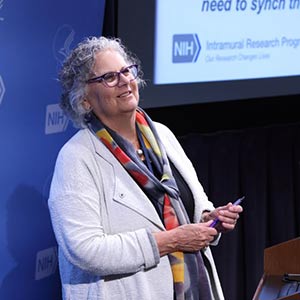 Williams’ lab continues to study APE2, working with other NIEHS researchers to further understand the role and regulation of APE2 in processing ribonucleotides embedded in DNA. (Photo courtesy of Steve McCaw)
Williams’ lab continues to study APE2, working with other NIEHS researchers to further understand the role and regulation of APE2 in processing ribonucleotides embedded in DNA. (Photo courtesy of Steve McCaw)NIEHS structural biologist Scott Williams, Ph.D., and collaborators in Canada reported a key vulnerability of breast cancer cells that lack proteins coded for by the BRCA1 and BRCA2 genes. The study, published June 18 in the journal Molecular Cell, holds promise for a precision medicine approach to treating breast cancers that arise from BRCA1 and BRCA2 mutations.
The vulnerability arises when a protein called APE2 is also lost. In a 2017 paper, Williams’ lab reported part of the APE2 crystal structure. “We believe that the shape of the molecule makes it likely that successful inhibitors can be identified,” he said, pointing to possible pharmaceutical therapies. Williams is deputy chief of the Genome Integrity and Structural Biology Laboratory.
Hobbling DNA repair
Because of Williams lab’s expertise in APE2 structure, Dan Durocher, Ph.D., from the Lunenfeld-Tanenbaum Research Institute in Toronto, contacted him in hope that together they could uncover the role of APE2 in BRCA-deficient tumors.
“Our collaborators used a panel of different human cell lines deficient in BRCA 1 and 2,” said Williams. “All of them died when the APEX2 gene was inactivated.”
Synthetic lethality, a broken chair
The new study highlights BRCA1-2 and APEX2 synthetic lethality, which means that the combined lack of both gene products is lethal to cells.
 Wojtaszek’s graduate work resulted in discovery of a molecule that interrupts a way cancers devleop drug resistance. She is hopeful the new study will lead to a similar outcome. (Photo courtesy of Steve McCaw)
Wojtaszek’s graduate work resulted in discovery of a molecule that interrupts a way cancers devleop drug resistance. She is hopeful the new study will lead to a similar outcome. (Photo courtesy of Steve McCaw)BRCA proteins are central to regulating a process called homologous recombination to repair DNA lesions incorporated into the genome. Without BRCA, cells rely on backup strategies.
The team was surprised to find that APE2 serves as a backup to BRCA, according to co-lead author Jessica Wojtaszek, Ph.D., a postdoctoral fellow in Williams’ lab. Other co-authors from the Williams lab were biologist Denise Appel and postbaccalaureate fellow Tejas Patel.
“APE2 had historically been relegated to serving as a backup to APE1,” said Wojtaszek. APE1 is active in a different repair process, called base excision repair.
“This study was very satisfying in that it reports vertebrate APE2, although having overlapping capabilities with [other nucleases], has a unique ability with respect to processing complex DNA lesions arising from ribonucleotides embedded in DNA,” said Wojtaszek.
Redundant DNA repair pathways can be imagined as legs on a chair. When all legs are intact —all repair processes working — the system is stable. Removing one leg of the chair causes instability.
“In the case of BRCA-deficient tumors, this instability contributes to tumor progression,” Williams explained. “Removal of another leg — APE2 — causes the system to topple, resulting in death of the tumor cells.”
Breakthrough from studying damage source
The team combined analyses of genome-wide interactions with structural and biochemical studies to discover the mechanism underlying APEX2 and BRCA1-2 synthetic lethality.
 Patel is an Intramural Research and Training Award postbaccalaureate fellow from Illinois State University who has completed previous projects on APE2. (Photo courtesy of Steve McCaw)
Patel is an Intramural Research and Training Award postbaccalaureate fellow from Illinois State University who has completed previous projects on APE2. (Photo courtesy of Steve McCaw)They observed that cells died even without exposures to outside agents, or exogenous damage. This finding suggested that APE2 helps repair damage from natural body processes, or endogenous damage, such as RNA lesions (see sidebar).
Coming full circle
For Williams, the study represents a sort of full circle in his career. As a doctoral student in Canada, he studied the BRCA1 protein at the molecular level and how mutations in it compromised its functions. This was his introduction to the DNA repair field, and he has been focused on it since.
In 2009, he joined NIEHS, where seminal studies published in 1994 identified BRCA mutations. “We’ve gone from understanding how BRCA is breaking, or mutating, to learning how we can target tumors resulting from those mutations,” Williams remarked.
Promise for personalized medicine
“Synthetic lethality is one approach the field is taking to meet the challenge of personalized medicine,” he said. “What tools can we use to target this specific breast cancer tumor, to exploit its Achilles’ heels?”
 Appel has co-authored a number of papers that shed light on DNA lesions and mechanisms of their repair.
Appel has co-authored a number of papers that shed light on DNA lesions and mechanisms of their repair.Cell lines used in this study had complete loss of the BRCA gene functions. Williams stressed that may not always be true in a patient’s cells. “Depending on the type of mutation a person has, inactivating APE2 may be more or less beneficial,” he said, suggesting a direction for future work.
Citations:
Alvarez-Quilon A, Wojtaszek JL, Mathieu MC, Patel T, Appel CD, Hustedt N, Rossi SE, Wallace BD, Setiaputra D, Adam S, Ohashi Y, Melo H, Cho T, Gervais C, Munoz IM, Grazzini E, Young JTF, Rouse J, Zinda M, Williams RS, Durocher D. 2020. Endogenous DNA 3’ blocks are vulnerabilities for BRCA1 and BRCA2 deficiency and are reversed by the APE2 nuclease. Mol Cell 78(6):1152–1165.e8.
Futreal PA, Liu Q, Shattuck-Eidens D, Cochran C, Harshman K, Tavtigian S, Bennett LM, Haugen-Strano A, Swensen J, Miki Y, Eddington K, McClure M, Frye C, Weaver-Feldhaus J, Ding W, Gholami Z, Soderkvist P, Terry L, Jhanwar S, Berchuck A, Inglehart JD, Marks J, Ballinger DG, Barrett JC, Skolnick MH, Kamp A, Wiseman R.1994. BRCA1 mutations in primary breast and ovarian carcinomas. Science 266(5182):120–122.
Wallace BD, Berman Z, Mueller GA, Lin Y, Chang T, Andres SN, Wojtaszek JL, DeRose EF, Appel CD, London RE, Yan S, Williams RS. 2017. APE2 Zf-GRF facilitates 3’-5’ resection of DNA damage following oxidative stress. Proc Natl Acad Sci U S A 114(2):304–309.









